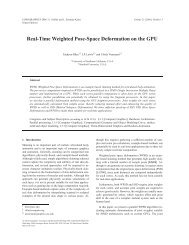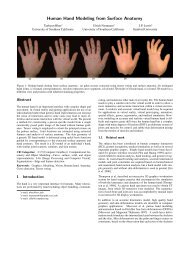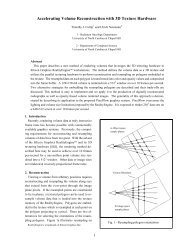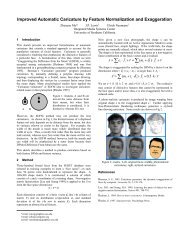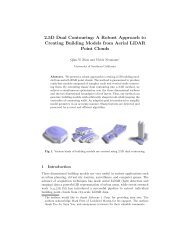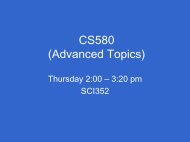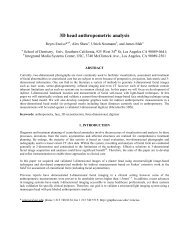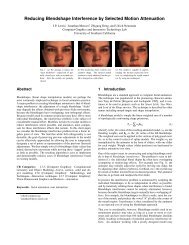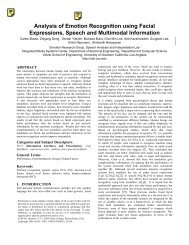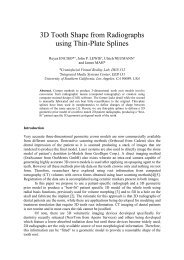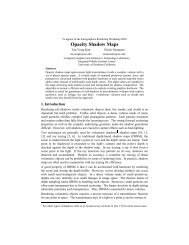The Gixel Array Descriptor (GAD) for Multi-Modal Image Matching
The Gixel Array Descriptor (GAD) for Multi-Modal Image Matching
The Gixel Array Descriptor (GAD) for Multi-Modal Image Matching
Create successful ePaper yourself
Turn your PDF publications into a flip-book with our unique Google optimized e-Paper software.
Figure 10. More results <strong>for</strong> matching with <strong>GAD</strong> (left) and recall vs. 1 − precision curve comparison (right). (a) <strong>Matching</strong> with JPEG<br />
compression (image 1 and 2 from the “Ubc” series [1]) (b) <strong>Matching</strong> with illumination change (image 1 and 4 from the “Leuven” series [1])<br />
likely helps in reducing the impact of JPEG compression.<br />
In Fig.10(b) with illumination change, the <strong>GAD</strong> has a recall<br />
rate slightly inferior to other descriptors, but still finds<br />
a large number of correct matches with almost no errors.<br />
5.5. Processing Time<br />
<strong>GAD</strong>’s computation process is time-consuming compared<br />
to state-of-the-art descriptors, but no ef<strong>for</strong>ts at optimization<br />
have been made yet. For examples, Fig.1 (size<br />
512x512) takes <strong>GAD</strong> 8.9 seconds, while SURF needs 0.7s;<br />
Fig.10(b) (size 900x600) takes <strong>GAD</strong> 19.5s, while SURF<br />
needs 1.3s. At this point, speed is not a primary concern in<br />
our research, but we’ll pursue optimizations in future work.<br />
6. Conclusion<br />
We introduce a novel descriptor unit called a <strong>Gixel</strong>,<br />
which uses an additive scoring method to extract surrounding<br />
edge in<strong>for</strong>mation. We show that a circular array of <strong>Gixel</strong>s<br />
will sample edge in<strong>for</strong>mation in overlapping regions to<br />
make the descriptor more discriminative and it can be invariant<br />
to rotation and scale. Experiments demonstrate the<br />
superiority of the <strong>Gixel</strong> array descriptor (<strong>GAD</strong>) <strong>for</strong> multimodal<br />
matching, while maintaining a per<strong>for</strong>mance comparable<br />
to state-of-the-art descriptors on traditional single<br />
modality matching.<br />
<strong>The</strong> <strong>GAD</strong> still has some limitations in its current development<br />
status. We have put little ef<strong>for</strong>t into optimization,<br />
so the run time is slow. In addition, though <strong>GAD</strong> exhibits<br />
rotation and scale invariance, large viewpoint changes may<br />
reduce per<strong>for</strong>mance, and we have not addressed that issue<br />
yet. Finally, as a feature built sole on edges, <strong>GAD</strong> may not<br />
per<strong>for</strong>m well in situations where edges are rare. <strong>The</strong>se issues<br />
will be investigated sin our future work.<br />
References<br />
[1] K. Mikolajczyk and C. Schmid. A per<strong>for</strong>mance evaluation of<br />
local descriptors. IEEE Transactions on Pattern Analysis and<br />
Machine Intelligence, 27(10):1615–1630, 2005. 2, 4, 5, 7, 8<br />
[2] H. Bay, A. Ess, T. Tuytelaars, L. Van Gool. SURF: Speeded<br />
Up Robust Features. Computer Vision and <strong>Image</strong> Understanding,<br />
110(3):346–359, 2008. 2, 5<br />
[3] R. Zabih and J. Woodfill. Non-parametric local trans<strong>for</strong>ms <strong>for</strong><br />
computing visual correspondance. Proceedings of the European<br />
Conference on Computer Vision, pp.151–158, 1994. 2<br />
[4] A. Johnson and M. Hebert. Object recognition by matching<br />
oriented points. Proceedings of the IEEE Conference on Computer<br />
Vision and Pattern Recognition, pp.684–689, 1997. 2<br />
[5] S. Belongie, J. Malik, and J. Puzicha. Shape matching and<br />
object recognition using shape contexts. IEEE Transactions<br />
on Pattern Analysis and Machine Intelligence, 24(4):509–522,<br />
2002. 2<br />
[6] D. Lowe. Distinctive image features from scale-invariant keypoints.<br />
International Journal of Computer Vision, 60(2):91–<br />
110, 2004. 2, 5<br />
[7] Y. Ke and R. Sukthankar. PCA-SIFT: A more distinctive representation<br />
<strong>for</strong> local image descriptors. Proceedings of the<br />
IEEE Conference on Computer Vision and Pattern Recognition,<br />
pp.511–517, 2004. 2<br />
[8] M. Calonder, V. Lepetit, C. Strecha, and P. Fua. BRIEF: Binary<br />
Robust Independent Elementary Features. Proceedings of<br />
the European Conference on Computer Vision, 2010. 2, 5<br />
[9] E. Rublee, V. Rabaud, K. Konolige, G. Bradski. ORB: an efficient<br />
alternative to SIFT or SURF. Proceedings of the IEEE<br />
International Conference on Computer Vision, 2011. 2, 5<br />
[10] F. Tang, S. H. Lim, N. L. Chang , H. Tao. A novel feature<br />
descriptor invariant to complex brightness changes. Proceedings<br />
of the IEEE Conference on Computer Vision and Pattern<br />
Recognition, pp.2631–2638, 2009. 2<br />
[11] A. Bosch, A. Zisserman, and X. Munoz. <strong>Image</strong> classification<br />
using random <strong>for</strong>ests and ferns. Proceedings of the IEEE<br />
International Conference on Computer Vision, 2007. 2<br />
[12] E. Shechtman and M. Irani. <strong>Matching</strong> local self-similarities<br />
across images and videos. Proceedings of the IEEE Conference<br />
on Computer Vision and Pattern Recognition, 2007. 2<br />
[13] S. Leutenegger, M. Chli and R. Siegwart. BRISK: Binary<br />
Robust Invariant Scalable Keypoints, Proceedings of the IEEE<br />
International Conference on Computer Vision, 2011. 2<br />
[14] S. Winder, G. Hua, M. Brown. Picking the best DAISY. Proceedings<br />
of the IEEE Conference on Computer Vision and<br />
Pattern Recognition, pp.178-185, 2009. 3<br />
[15] G. Yang, C. V. Stewart, M. Sofka, C. L. Tsai. Registration of<br />
Challenging <strong>Image</strong> Pairs: Initialization, Estimation, and Decision.<br />
IEEE Transactions on Pattern Analysis and Machine<br />
Intelligence, 29(11):1973–1989, 2007. 7



